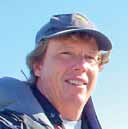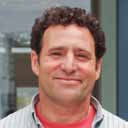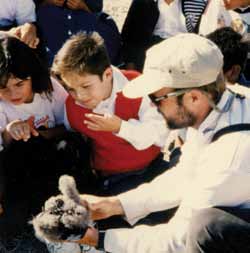When UC Santa Cruz grad student Brad Keitt came to the wind-swept island of Isla Natividad off Baja California, he found a fishing village of about 400 people and an ecological disaster in the making.
The island was home to a mysterious seabird known as a black-vented shearwater, a bird that haunted the night, nested in underground burrows, and could dive to depths of more than 100 feet in the ocean. Ninety-five percent of the entire species bred on that tiny island.
The problem was, the shearwaters, whose eerie nighttime cries sound like a cross between a coyote and a rooster, were disappearing. During the critical breeding season, feral cats, brought to the island to rid fishermen's houses of native deer mice, were killing 1,000 birds each month.
A protégé of two maverick UCSC biologists, Don Croll and Bernie Tershy, who had cobbled together a plucky, seat-of-thepants conservation team that saved threatened species by clearing islands of invasive predators, Keitt got to work.
Headquartered in a plywood shed behind the village market, Keitt studied the shearwaters by night and served as a cheerleader for the bird by day. Keitt took school children on field trips, told fishermen of the birds' amazing abilities, and drove home the fact that this enigmatic bird was their bird, found almost nowhere else on Earth.
Within three years, villagers had adopted the shearwater as their island mascot and were asking Keitt to help them get rid of the marauding felines.
The following year, not only did the Mexican government outlaw cats on Isla Natividad, but all the wild felines had been removed.
Shearwater mortality dropped to less than 100 per month.
Today, Keitt, 45, is director of conservation for a $6.5-milliona- year nonprofit called Island Conservation, which grew out of Croll and Tershy's work.
Over the past two decades, the Santa-Cruz based organization has eradicated rats from Anacapa Island, allowing the number of Scripps's Murrelet nests to increase four-fold; removed packs of voracious goats that had turned the once-lush Guadalupe Island in Mexico into a near moonscape; and rid Allen Cay in the Bahamas of invasive mice, which were contributing to the destruction of native shearwaters and iguana habitat. In all, the organization reports it has saved 389 species from possible extinction on 52 islands around the world.
"It's incredibly rewarding," said Keitt of the work he has been doing for the past 18 years. "I feel lucky to have a job where I am making a difference that is so immediate yet lasting."
Science into action
Islands make up only 5 percent of the world's landmass, but they are home to 20 percent of all bird, reptile, and plant species. And nowhere are extinctions greater.
Ninety-five percent of bird species that have gone extinct once lived on islands, along with 80 percent of extinct reptiles and 55 percent of extinct mammals. Combined with the fact the pace of extinctions is ramping up worldwide, the importance of preserving island species becomes apparent.
Those facts were not lost on Tershy and Croll, a pair of scientists, surfers, and self-professed seabird freaks, who, 20 years ago—right about the time they began as UCSC research biologists—started their own two-man crusade to rid invasive species from islands in Baja California.
"These were projects we were doing in our spare time," said Tershy, a youthful-looking 52-year-old. "We were gentleman conservationists."
Inspired by conservation work in New Zealand and by ornithologist Kenneth Stager—who, in 1958, arrived on Clipperton Island with a shotgun and single-handedly wiped out a pack of feral pigs that was decimating the island's land crabs and seagoing albatrosses—Croll and Tershy grabbed their surfboards and traveled to a pair of wind-wracked Mexican islands. There, feral cats were obliterating Cassin's Auklets, Scripps's Murrelets and Black Storm-Petrels.
"We can do this," Tershy remembered saying to Croll.
With the help of a legendary California bobcat trapper, the scruffy, underfinanced environmental tacticians managed to clear the islands of the destructive felines, allowing native bird populations to rebound.
Within five years, the two had assembled a rag-tag team of grad students, trappers, and Mexican conservationists, freeing nine islands off Baja California of invasive rats, feral cats, rabbits, goats, and burros. They called themselves Island Conservation and Ecology Group and established a formal working relationship between UCSC and their budding nonprofit.
That idea of science as a foundation for action was fueled, they said, by two legendary UCSC professors: Ken Norris, renowned marine-mammal researcher and founder of Long Marine Lab (read about a gift honoring the legacy of Ken Norris), and Michael Soulé, who was chairman of UCSC's Environmental Studies Department and known as the father of conservation biology.
One day, they said, Soulé proposed this question: What if you could remove all the invasive species from the world's islands? That mind-blowing concept formed the basis for Island Conservation's model of research, conservation action, and result.
"To us it was: Why apply science just to describe problems?" said Croll, a flip-flop-wearing 56-year-old. "Using science to find solutions seemed way more interesting."
Global reach
Island Conservation's headquarters sits in an unassuming office building not far from the Pacific Ocean. Its 35 employees, however, range around the globe: from Hawaii to the Caribbean, from the Galapagos to Australia.
They gather scientific data, work with local governments and island residents, secure permits, enlist the help of other conservation organizations, and orchestrate removal of invasive vertebrates. They also contract with independent researchers to evaluate which species recover, and how well, after eradications are complete.
One such project got underway on a remote Aleutian landmass called Rat Island. There, a UCSC study found, shipwrecked Norwegian rats were killing nesting seabirds and small land birds, causing a chain-reaction of ecological destruction. Without seabirds eating snails, limpets, and other grazers, the intertidal zone was being stripped bare of seaweed. Island Conservation, along with the U.S. Fish and Wildlife Service and The Nature Conservancy, undertook a rat eradication in 2008 and today, according to Croll, researchers have documented the return of four bird species and an increase in avian populations overall.
But projects are not always problem-free. On Rat Island, bald eagles died after coming from other islands and feeding on poisoned rats. And when Island Conservation, working with the Channel Islands National Park and others, began efforts to rid Anacapa of its rodents, animal rights activists filed a lawsuit. Some called the use of poison cruel.
Keitt of Island Conservation understands the gut reaction to animal deaths, and said Island Conservation is committed to the humane treatment of native and invasive animals in its research and conservation work. But, he noted, "If we don't do what we do, we are losing entire species forever."
And the destruction of native species by invasive vertebrates is no less cruel than getting rid of already abundant animals, according to Croll, who pointed to a video of mice literally eating a fluffy albatross chick alive.
"It's not any of these introduced species' fault that they're on these islands—in many ways, it's humans' fault," Croll said, "but that doesn't mean it's OK to let the destruction happen."
Island Conservation's successes far outweigh its disappointments, however, and subsequent research by UCSC has found that the bald eagle population has recovered on Rat Island, which has been officially rechristened Hawadax, its traditional Aleut name. And, saving species, even one at a time, helps protect biodiversity, which, in turn, allows our delicately balanced ecosystem to continue to function.
While Tershy and Croll have moved on to other projects, UCSC still has a strong presence in the organization. Internships are offered to undergraduates, and grad students do research projects in collaboration with the group. Five of Island Conservation's 35 employees are UCSC alumni, including David Will, who graduated in 2008 with a degree in bioinformatics.
Not only has Will taken part in eradication projects, once sleeping for months in a shipping container welded to the deck of a heaving ship, but he is also now working on an Island Conservation database project to prioritize the world's 465,000 islands for conservation efforts.
Started by graduate student Dena Spatz in Tershy and Croll's Coastal Conservation Action Lab, the Threatened Island Biodiversity Database is now an elegant, searchable map (at tib.islandconservation.org) that allows a user to click on islands around the globe and discover which threatened and invasive species live there. Some 20 UCSC students gathered data for the project.
From bare to lush
Ask Keitt about Island Conservation's most visible success and he'll point to Isla Guadalupe, a 100-square mile, volcanic island 150 miles off Baja.
Once a lush paradise of pine and cypress forests, seal hunters arriving in the late 1800s brought goats to the island for food. By the time Island Conservation arrived, thousands of cloven-hooved foragers had turned the island into a near wasteland. Native plants were mowed into oblivion, birds struggled to survive, and only about 200 pine trees had survived the goats' onslaught.
With the help of local laborers, Keitt erected fences around a dozen small plots of land. Within six months, non-native grasses were growing inside the enclosures, but so too were pine seedlings and native species that hadn't been seen in years.
Armed with evidence of what was possible, Island Conservation and its Mexican counterpart, Conservación de Islas, received government support to remove the caprine invaders. Today, the island is home to about 10,000 new cypress and pine trees, along with island snapdragons and Guadalupe fan palms.
In 2005, the Mexican government declared the area a protected biosphere reserve.
Sitting in his office, dotted with bird drawings and photos from Island Conservation projects, Keitt said he has a dream.
"I dream about someday taking my kids to some of the islands where I worked and saying, 'I remember when there were no birds or trees here, and now look at it: It's thriving,'" he said.
"I hope they'll appreciate that."
Peggy Townsend is a freelance writer based in Santa Cruz.




